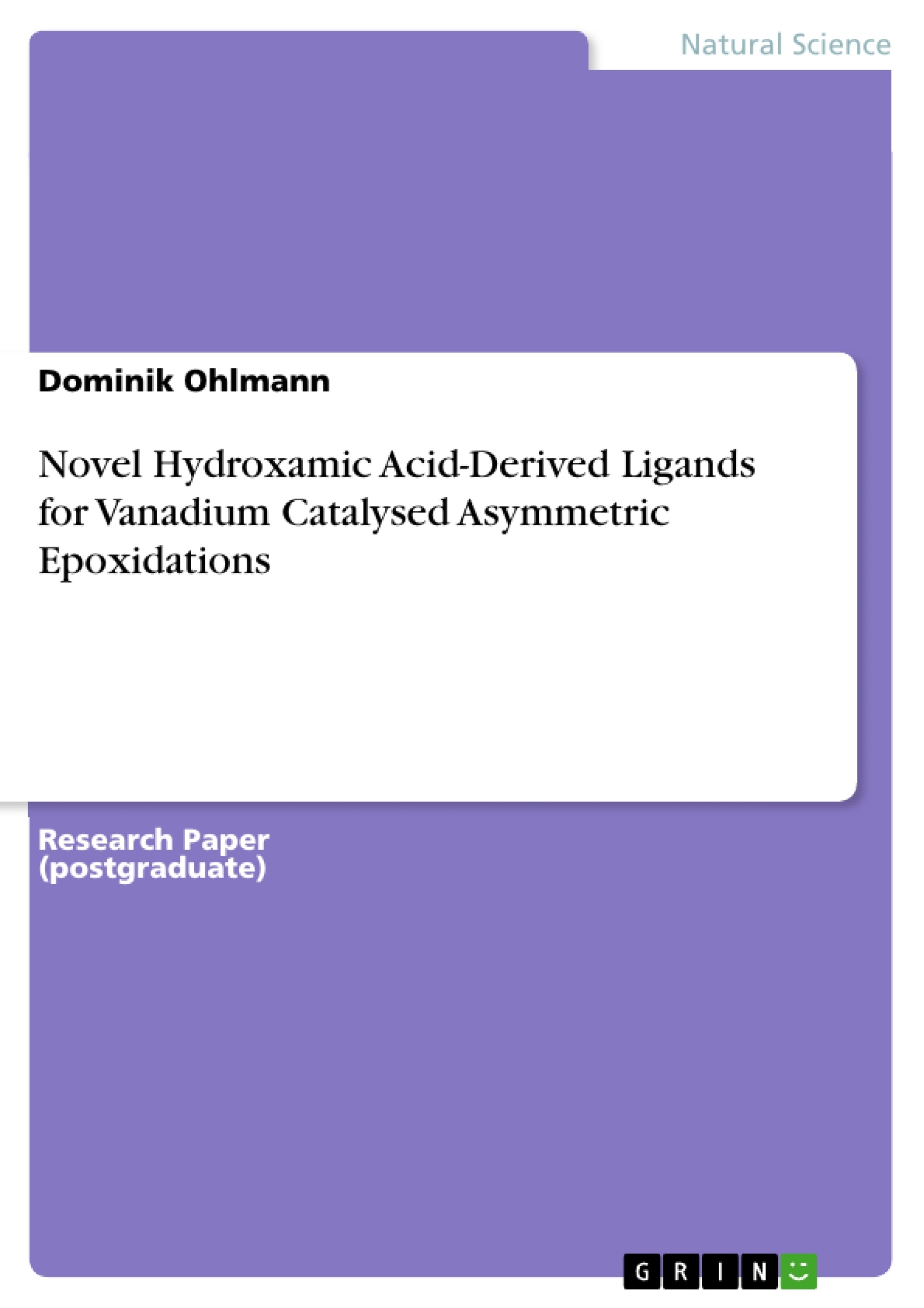During this project, we reached the aim of establishing synthetic routes to new hydroxamic acid derivatives, which were used as ligands for asymmetric epoxidation of allylic alcohols in water. Three new ligands, (S, R)-3, (S, S)-3 and 14 were successfully synthesized and subsequently tested on standard substrates. To accomplish the ligand synthesis, we used known procedures as well as new ones, for example the coupling of in situ-protected hydroxylamine 5a and activated mixed anhydride 13. As yields were not always satisfying (see Experimental), optimization of several steps could be a general aim for future work, especially considering the synthesis up-scaling of promising ligand 14.
Inhaltsverzeichnis (Table of Contents)
- Introduction
- Sharpless Epoxidation
- Yamamoto-Malkov Epoxidation
- Camphor Derivatives
- Phosphinamides
- Sulfinamides
- Project Objective
- Results and Discussion
- Synthesis of ligands 3
- Camphor-derived hydroxamic acids
- Application of ligand 3 to vanadium-catalyzed epoxidation
- Hydroxamic acid based on diphenylphosphinamide moiety
- Synthesis of ligand 14
- Application of ligand 14 to vanadium-catalyzed epoxidation
- Hydroxamic acids containing sulfinamide moiety
- Synthesis of ligand 19 using direct method
- Synthesis of ligand 19 using Nosyl protecting group
- Synthesis of N-Benzhydryl-hydroxylamine 5
- Conclusions and Future Aspects
- General
- Camphor derivatives
- Sulfinamides
- Phosphinamides
- Anilides
- Binaphthyls
- Experimental
- General Methods
- Synthesis of hydroxylamine
- Synthesis of Camphor-derived hydroxamic acids
Zielsetzung und Themenschwerpunkte (Objectives and Key Themes)
This report aims to explore the synthesis and application of novel hydroxamic acid-derived ligands for vanadium-catalyzed asymmetric epoxidations. The research focuses on developing efficient and selective catalysts for the epoxidation of various olefins.
- Synthesis of new hydroxamic acid-derived ligands
- Application of these ligands in vanadium-catalyzed epoxidation reactions
- Evaluation of the catalytic activity and enantioselectivity of the developed systems
- Investigation of the structure-activity relationships of the ligands
- Exploration of potential applications of the epoxidation reactions
Zusammenfassung der Kapitel (Chapter Summaries)
The report begins with an introduction to the field of asymmetric epoxidation, highlighting existing methods and relevant catalyst systems. The project objective focuses on the development of novel hydroxamic acid-derived ligands for vanadium-catalyzed epoxidations. The main body of the report delves into the results and discussion, outlining the synthesis and characterization of various ligands. The report discusses the application of these ligands in the vanadium-catalyzed epoxidation of different olefins, analyzing the obtained results and drawing conclusions regarding the catalytic activity and enantioselectivity of the developed systems. The report further explores the structure-activity relationships of the ligands, aiming to understand the factors influencing the catalytic performance. Finally, the report concludes with a discussion of future aspects and potential applications of the epoxidation reactions.
Schlüsselwörter (Keywords)
The key focus topics of this report are the synthesis and application of hydroxamic acid-derived ligands in vanadium-catalyzed asymmetric epoxidations. Key terms include: vanadium catalysis, asymmetric epoxidation, hydroxamic acids, ligands, enantioselectivity, structure-activity relationships, and catalyst design. The research aims to develop efficient and selective catalysts for the epoxidation of various olefins.
- Quote paper
- Dominik Ohlmann (Author), 2007, Novel Hydroxamic Acid-Derived Ligands for Vanadium Catalysed Asymmetric Epoxidations, Munich, GRIN Verlag, https://www.hausarbeiten.de/document/463480



